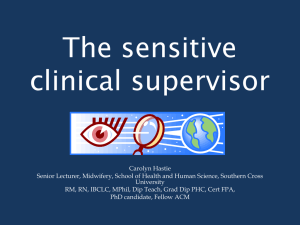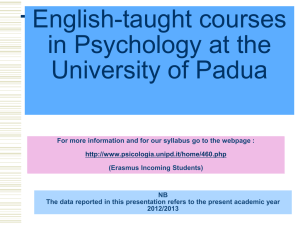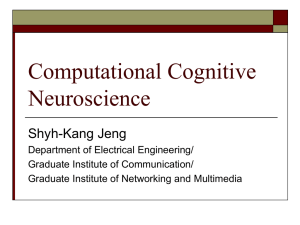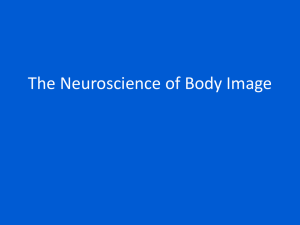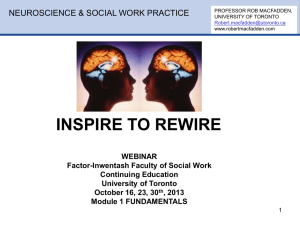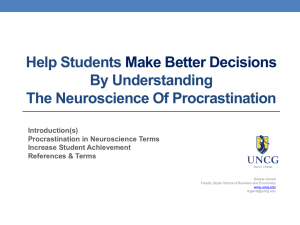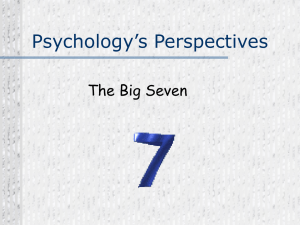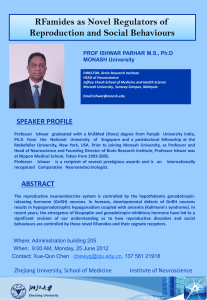Social Work Practice in the Time of Neuroscience
advertisement
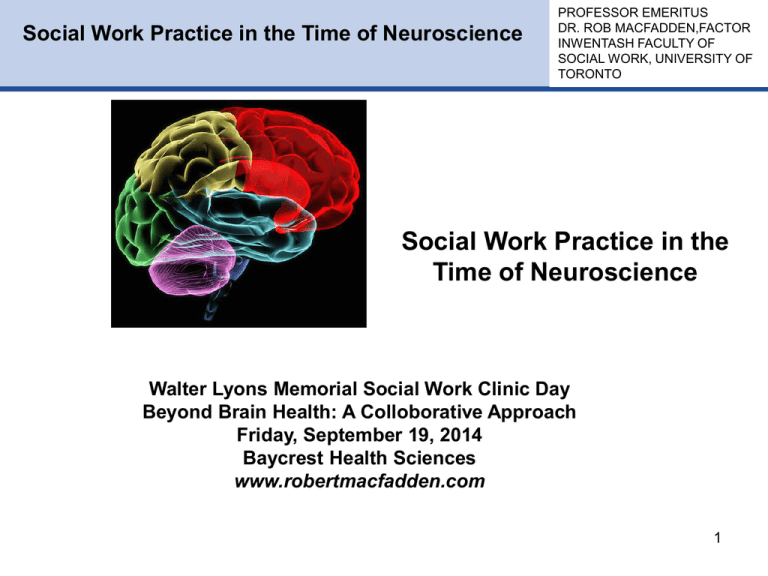
Social Work Practice in the Time of Neuroscience PROFESSOR EMERITUS DR. ROB MACFADDEN,FACTOR INWENTASH FACULTY OF SOCIAL WORK, UNIVERSITY OF TORONTO Social Work Practice in the Time of Neuroscience Walter Lyons Memorial Social Work Clinic Day Beyond Brain Health: A Colloborative Approach Friday, September 19, 2014 Baycrest Health Sciences www.robertmacfadden.com 1 Social Work Practice in the Time of Neuroscience BIO-PSYCHO-SOCIAL “The Missing Link” For decades social work has committed itself to a biopsychosocial perspective with little evidence of the profession embracing the biological side. With the new knowledge emerging from neuroscience, social work is at a crossroad in adoption of this new paradigm. Advances in imaging and other technologies have opened a vista into the brain to reveal the fundamental components and processes that underlie our thinking, feeling and action. Rosemary Farmer (2009), a social worker, has identified this focus on the brain as the “missing link” for our profession. 2 Social Work Practice in the Time of Neuroscience We are a species that requires the most home assembly; brain continues to mature right into the twenties. It changes throughout all of our lifetimes Emotion powers our lives. It is a background and foreground influence. Understanding fear,safety and love is critical to understanding people and for intervention. 3 Social Work Practice in the Time of Neuroscience The brain has developed over millennia and this history influences who we are today. The brain is an archeological record. (Triune Brain by Paul MacLean) In general terms, the brain can be seen in terms of three evolutionary components: The reptilian brain was the first core to develop and is basic life sustaining, controlling key functions such as respiration, circulation, the endocrine system, reproduction, arousal & homeostasis. Much is reflexive and drive based- fear, rage, eating, and mating which still retains a degree of control over our actions. (Brainstem) 4 Social Work Practice in the Time of Neuroscience The paleomammalian brain was added on and brought with it learning, memory and emotion. (Limbic system) The neomammalian brain was a third addition and brought enhanced cognition, enhanced social connection and sense of self and selfawareness. Problem-solving was enhanced and an increased emphasis on social connection enabled us to organize into larger communities, to increasingly plan ahead and to learn more from experience. (Cortex) 5 Social Work Practice in the Time of Neuroscience Louis Cozolino describes psychotherapy in “It’s a Jungle in There” (Psychotherapy Networker 2008 September/October) is like working with an anachronistic menagerie- a human, a horse and a crocodile within the same body. Our skull shares its space with ancient brain equipment and our functioning requires integrating and coordinating these highly specialized and complex systems. These areas of our brain can vie for dominance and experience conflict with each other without us being conscious of this. 6 Social Work Practice in the Time of Neuroscience http://www.youtube.com/watch?v=DDlfP1FBFk “FLIPPING YOUR LID” Dan Siegel’s Brain Hand Puppet from Siegel & Hartzell (2003), Parenting from the inside out. P.173 7 Social Work Practice in the Time of Neuroscience Velcro for Negatives: Tilted towards Anxiety and Fear Evolution favours an anxious gene (Aaron Beck). We can be anxious/fearful about anything (e.g., our furniture) Human condition is tilted towards anxiety or fear Different Neuroplastic Properties Hippocampus Etch a sketch-repeatedly Influenced by experience Constantly remodeled Amygdala Keeps a constant dendritic profile-memory Generalizes to as many situations as possible Can make us rigid Therapists are amygdala whisperers: work to build networks of new learnings in hippocampus & prefrontal cortex 8 Empathy, warmth, positive regard creates the nourishing Social Work Practice in the Time of Neuroscience During fear and stress, Broca’s area (speech) inhibited. Yet we need to put feelings into words & narratives to support emotional regulation. Involves integration cognitions and emotions. Broca’s area also involved in prediction & anticipation. Impacts good choices & victimization and dissociation. 9 Social Work Practice in the Time of Mindfulness and Neuroscience Most Important Discovery in Neuroscience? Neuroplasticity and Neurogenesis 10 Social Work Practice in the Time of Mindfulness and Neuroscience Neural Circuitry: We’re all electricians. Circuits are being formed, weakened, strengthened, and purged. Experience is like a scalpel. Much happening unconsciously and may be consciously driven. Meditation is an act of circuit building- if you have an awareness of this, then it’s a conscious act of circuit building.The ability to control and to direct your attention is essential to well-being. It is the core of emotional regulation. Secret to deliberate circuit building: paying attention. Intentional attention. The ability to connect with, attune to, and help build new neural connections at the heart of psychotherapy. We are all gardeners, helping each other manage and grow our gardens. 11 Social Work Practice in the Time of Mindfulness and Neuroscience Reacting to Challenges: the Autonomic Nervous System: Stephen Porges & the Polyvagal Theory Excerpted from stephenporges.com Neuroception describes how neural circuits distinguish whether Porgessituations believes our nervous system is in a constant quest for safety. 12 Social Work Practice in the Time of Mindfulness and Neuroscience 13 Social Work Practice in the Time of Neuroscience The face and voice are significant channels through which safety is communicated to another. Face is the area particularly where presence is communicated to the client (Geller and Greenberg). Faces are information centres along with voice. Over time, the therapist’s warm facial connection, receptive posture, open heart and listening presence promotes safety and neural regulation of the client’s physiology, strengthening emotional regulation. Therapist’s preparation involves cultivating personal presence prior to meeting. This is internal attunement which generates calm and safety within the therapist. Therapeutic presence involves attuning to oneself and one’s felt sense of the client. Feeling felt impacts the client’s physiology though calming feelings of safety. 14 Social Work Practice in the Time of Neuroscience Much of this is also non-verbal. Therapy is not merely the talking cure, but the communication cure. The therapist’s whole being functions like a tuning fork, resonating, attuning and feeling empathy. This is highly interactional between the therapist and client. The therapist senses the client and is changed from this feedback. Emotions experienced by the client are being experienced by the therapist and his/her feeling and body state changes. The client senses this change and if there is attunement, the client “feels felt” which is the sweet spot for change. 15 Social Work Practice in the Time of Neuroscience In mindfulness, Siegel believes the process of following your breath in a certain way and with certain mental filters, leads to the meditator developing a positive, supportive relationship with oneself. This is similar to us being a secure parent to ourselves. We are responsive, accessible and attuned to our behaviour, feelings and perceptions. Therapists talk about creating a supportive, holding environment with clients. Mindfulness is a form of a supportive, holding relationship with ourselves. 16 Social Work Practice in the Time of Neuroscience The “social” part of the term “social worker” underscores our profession’s recognition of the essential nature of relationships to our existence. Neuroscience, similarly, has revealed how fundamental relationships are to our brains, mind and bodies. Human connections help to shape neural connections. Relationships essentially sculpt our brains. As a species we are, “Wired to Connect” (Fishbane, 2007). Louis Cozolino (2010) asserts that there are no single brains and that the brain, besides its genetic component, is a “social organ” developed through interaction with others. 17 Social Work Practice in the Time of Neuroscience Mirror neurons are neural components designed to pay attention to the behaviours, feelings, intentions of others and to provide this information to our brains. This is a type of social Wi-Fi. When we watch others, the mirror neurons pick up these cues and through the collaboration of other brain components such as the insula, this information flows throughout our body and brain. Aspects of our body resonate with this information and change parts of our own physiology. These changes are sent up the insula and into our prefrontal cortex which perceives these changes as a “feeling”. Thus, in watching others, we resonate and our bodies change to attune and to reflect these states in others. We are able to feel empathy for the other. The mirror neuron system in others sense the change in our bodily states and resonates with these changes and the other “feels felt” by us. 18 Social Work Practice in the Time of Neuroscience Therapeutic relationships are viewed as forms of attachment relationships which create the conditions for optimal change. Interpersonal relationships involve biochemical changes which result in many things including new neural connections and learning. This new perspective views social workers as physical change agents involved in stimulating new neural connections. 19 Social Work Practice in the Time of Neuroscience Positive Emotions: Hanson and Happiness. Inner strengths include character virtues such as generosity, modesty, patience, and also secure attachment, executive self-regulation, distress tolerance, resilience, plus mindfulness, compassion and loving-kindness and positive emotions. These are related to happiness. Have to activate inner states first, then install them. Fostering states until they become traits is the secret. Negative states can quickly become negative neural traits. Most positive states are wasted because they are too short-term. Need to transfer short term states from short-term memory buffers to long term storage or no lasting value. 20 Social Work Practice in the Time of Neuroscience H-E-A-L PROCESS Have- you have the positive experience – notice one or create one Enrich. Increase duration, intensity, multimodality (bring into body, sit up proudly), Novelty heightens learning and increase personal relevance. Absorb. Visualize it sinking in, sense it, build it. Link. (optional). Hold positive feelings or thoughts or memories in awareness and introduce some painful thoughts, feelings, etc. (natural antidote). 21 Social Work Practice in the Time of Neuroscience The positive material will gradually associate with the negative material, soothing, easing and eventually replacing it. Have more episodes over the day, even 30 seconds at a time, half dozen times a day. Dozen or so seconds each time. Will turn activated states into traits eventually. It is startling to realize how unwilling the mind is to give the gift to oneself of a positive experience (Hanson). 22 Social Work Practice in the Time of Neuroscience Let us be grateful to people who make us happy. They are the charming gardeners who make our souls blossom. Marcel Proust 23 Social Work Practice in the Time of Neuroscience SOME PRACTICE TAKEAWAYS Need to understand how to explain the workings of the brain to clients and to appreciate the importance of the normalizing effect that this knowledge can have for many clients. The “handy” brain puppet is a useful tool for this purpose. Need to become experts in understanding and impacting the stress response. This involves understanding both the “brakes” (i.e., things that activate the parasympathetic system such as breathing, self-hypnosis, mindfulness) and the “accelerators” (e.g., sometimes a certain level of arousal is required). Clinicians need to be become “amygdala whisperers” and learn how to soothe the client’s fear and anxiety. Helping clients to learn how to self-soothe and helping partners and families to soothe each other is essential. Emotional regulation and coregulation. Positivity and positive emotions, the foundation of Positive Psychology, are extremely important. We need to help clients find positives in their lives and learn how to recognize them, savour them, and marinate in them. Also related to Strengths-based work. Building social support networks is another example of using positives. 24 Social Work Practice in the Time of Neuroscience SOME PRACTICE TAKEAWAYS We need to be sensitive to what we are communicating to client unconsciously (e.g., through non-verbal communication) and what implicit messages that agencies give off (e.g., messy and drab waiting room suggesting client low worth). Powerful right brain to right brain communication is occurring implicitly and is seen as the most important form of communication in terms of impacting the client. Use the mirror neuron system to “sense” the experience of the client but always check to see if your perceptions are accurate. Work to improve vertical integration (cortex with the brain stem and internal organs and visceral system) by promoting body work so that the client is able to be aware of internal sensations and improve the vertical low essential in integration and mental health. Work to improve horizontal integration (right brain to left brain communication) by exploring feelings, autobiographical self, experiences and how these connect with the left brain understanding through, for instance, the development of self-narratives. This enhances integration and mental health. 25 Social Work Practice in the Time of Neuroscience SOME PRACTICE TAKEAWAYS Understanding that evoking certain experiences, including intentional attention, activates neuroplasticity which helps to build new neural connections (i.e., learning) and the speed of the connections. Aerobic exercise, mindfulness practice, nutrition, therapeutic relationships can all promote neuroplasticity. Conditions that promote therapeutic change: positive therapeutic alliance with resonance, attunement, accurate empathy naming feelings and integrating into self-narrative feeling safe and feeling felt working on highly relevant goals with tasks that make sense incorporating self-soothing and co-soothing repairing relationship ruptures deliberately facilitating positives and positive emotions monitoring the therapeutic relationship and outcomes 26 Social Work Practice in the Time of Neuroscience SOME PRACTICE TAKEAWAYS Goal is to promote mental health and well-being. Key is promoting flow (versus chaos and rigidity) and integration (i.e., everything working together individually, and in harmony). Triangle of well-being: Empathic relationships, healthy mind and integrated brain. Integrating brain, coherent mind, empathic relationships Daniel J. Siegel 27 Social Work Practice in the Time of Neuroscience References Applegate, J., & Shapiro, J. (2005). Neurobiology for clinical social work: Theory and practice. NY: W.W. Norton & Company. Cozolino, Louis (2010). The neuroscience of psychotherapy: Healing the social brain. Second Edition. NY: W.W. Norton & Company. Damasio, A. (2001). Interviewed in the video, produced by David Grubin, Secret Life of the Brain. NY: Public Broadcasting System. Farmer, Rosemary (2009). Neuroscience and social work practice. Thousand Oaks, CA: Sage. Hanson, R., Mendius, R. (2009). Buddha’s brain. Oakland, CA: New HarbingerPublications. 28 Social Work Practice in the Time of Neuroscience Holzel, B., Lazar, S., Gard, T., Schuman-Olivier, Z., Vago, D., Ott, U.(2011). How does Mindfulness Meditation work? Proposing mechanisms of action from a conceptual and neural perspective. Perspectives on Psychological Science 6 (6), 537-559. MacFadden, R. (2011). Hypnosis and social work practice: Incorporating new perspectives from Neuroscience. In Turner, Frank. Social Work Treatment. Fifth Edition, Chapter 17, 271-278. MacFadden, R., Schoech, D. (2010). Neuroscience and professional decisionmaking: Implications for ICT. Journal of Technology in Human Services, 28:4, 282294. Saleebey, Dennis (1992). Biology's challenge to Social Work: Embodying the personin-environment. Social Work, 37(2), 112-118. 29 Social Work Practice in the Time of Neuroscience Schore, Allan (2012). The Science of the Art of Psychotherapy. NY: W. W. Norton & Company. Schore, Allan (2003). Affect regulation and the repair of the self. NY: W. W. Norton & Company. Seligman, Martin (2011). Flourish. NY: The Free Press. Siegel, Daniel J. (2013). The developing mind: How relationships and the brain interact to shape who we are. Second Edition. NY: Guilford Press. Siegel, Daniel J. (2010). The mindful therapist: A clinician’s guide to mindsight and neural integration. NY: W. W. Norton & Company. See also robertmacfadden.com for a range of related resources from documents to webinars. 30
